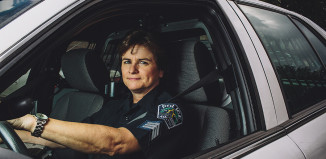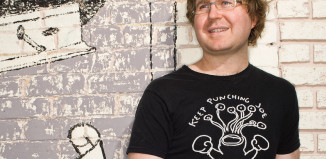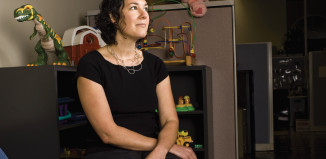Talk about a colossal task.
In 2004, the University of Texas at Austin tapped Ana Ixchel Rosal to form a new student support center from scratch. The just-approved Gender and Sexuality Center would serve as a safe space for students to explore and organize around LGBT and gender issues. But reaching out to such a diverse population across a huge campus wasn’t easy. Charged with everything from acquiring the furniture to developing an action plan, Rosal had her work cut out for her.
“When I look back on my career, I have a habit of starting things,” says Rosal whose background includes work with non- profit and LGBT organizations. “Even more than that sense of possibility for the center, I also appreciated the opportunity to work with students who were getting to see their dreams of opening the center realized.”
Indeed it had taken eight years to turn the concept of such a center on UT’s campus into an approved reality. During the first six years, those trying to get a women’s resource center were working separately from others attempting to open an LGBT one. It was incoming Dean of Students Teresa Brett who encouraged the two groups to join forces and increase the chance of getting a center serving both their needs. The strategy worked.
“I think it was difficult for administrators to see the need before the two groups came together,” Rosal says. “It was a combination of voices that eventually made it happen.”
Housed initially in a small closet-like space on campus, the center created a much-needed sanctuary for women and LGBT students – a place they could go and not be judged, analyzed, dismissed or disregarded. But more than a place of refuge, the center would give those students the support and tools they needed to go back out on campus and advocate for themselves.
Through the years, the goal has expanded to include education and advocacy. What started with Rosal as the only employee today includes three full-time employees and several part-time student workers. Each day is a renewed effort to reach as many people as possible. And that’s not easy. With nearly 50,000 students spread out over a 350-acre campus, individuals and small groups are often working in silos, unaware that there is a larger community of like-minded people nearby. For women and LGBT students, the center gives them a centralized “jumping off point” if you will – a place they can turn to in order to understand what’s happening at the university at large.
The raw numbers show the Gender and Sexuality Center has a vital place at UT. Last year, the center touched roughly 12,000 students in some way – from a single conversation at orientation to those who come into the space almost daily – that’s up from just 1,500 contacts in the center’s first year.
Still, how does one facility serve the diverse needs of the university’s women and LGBT communities? It’s a constant challenge, says Rosal. But bringing the two groups together has forged a kind of symbiotic relationship, with the queer community learning from the struggles of the female population and vice versa.
“There’s a tremendous amount of commonality,” Rosal says, “and I think that both communities would do well to understand the other’s perspective and build coalitions.”
For many gay and lesbian young adults, college is the first time they feel they can begin to explore their sexuality. But while Austin in general is considered an accepting place for gay people, a survey of LGBT-identified individuals on the UT campus conducted several years ago found that many continue to feel invisible and unwanted on campus.
“Discrimination wears and tears at you,” Rosal says. “You may feel physically safe, but you might be experiencing harassing comments that make you feel less safe. That’s a problem.”
And that’s where education – a growing part of the center’s mission – comes in. Last year, Rosal hired a full-time education coordinator to conduct training sessions across campus with students, faculty and staff on LGBT and some women’s issues. The sessions are designed to make more people aware and sensitive to what others around them are facing.
Additionally, earlier this year the center launched Peers for Pride, a program that enables both LGBT and straight ally students to use theatre to inform others on campus about LGBT issues. Participants are first brought up to speed on a multitude of topics and then trained to perform monologues for audiences around UT. A monologue could be from the perspective of an individual coming out, a parent struggling with their child’s sexuality or any number of other points of view.
The center is also working to become more integrated with the orientation process – reaching out to the newest students on campus to ensure they know the place exists. And for the second time this past May the center hosted its Lavender Graduation ceremony, a special graduation event commemorating the achievements of LGBT and ally students and allowing them to celebrate with those closest to them.
Rosal says one thing she’s learned is that there is no quintessential UT queer experience. People coming from bigger cities with large gay populations and strong activism such as Dallas or Boston may feel that the campus is behind the times in its support of LGBT students. At the same time, those coming from small town Texas, where being gay can be extremely difficult, often feel like UT is a welcomed change. It’s all about perspective.
Similarly, people at different stages of coming out are going to have different needs. Rosal points out that an individual who has been out since 16 and wants to be part of LGBT activism on campus is going to want something very different from the center than a person who is just beginning the coming out process. Still, it’s the job of the center to meet all of those needs equally.
Rosal says she’s received a handful of phone calls from parents of prospective students asking what life at UT will be like for their gay son or daughter. As more kids come out in high school and parental involvement in college selection increases, she says she expects those calls will increase.
Though a relatively young organization on campus, Rosal believes the center will continue to expand. Since its opening in 2004, the Gender and Sexuality Center has moved twice – each space a dramatic improvement over the last. Rosal says the Center is currently housed “in a beautiful space that was built just for us, but we’ve already outgrown it.” When the new Student Activity Center opens in 2011, the Gender and Sexuality Center will move there, becoming an even more central piece of the UT community.
“I hope to see the center be a really vibrant and essential piece of the campus, more connected to various departments and perhaps even sponsoring big events,” she says. “While we’ve come a long way in LGBT acceptance on campus, we are not quite at that level of visibility that says ‘you are one of us and you are part of us.’ One of the things we’re trying to figure out is how we can send that message.”
Rosal says she feels privileged to be able to have a positive effect on students at such a critical time in their lives. “It’s a hard time for so many because there is so much they’re negotiating,” she says. “I feel like I’m getting to do really meaningful work.”




































